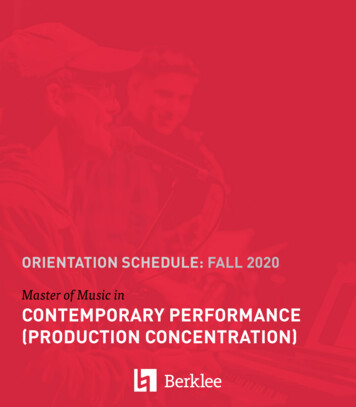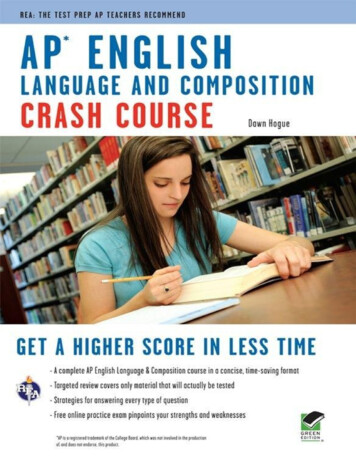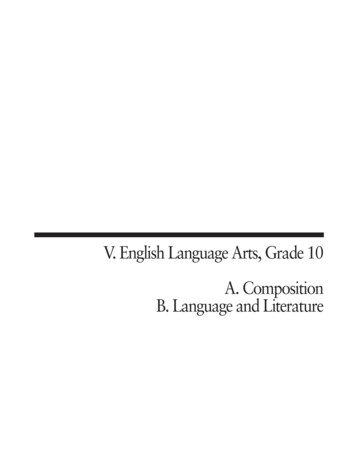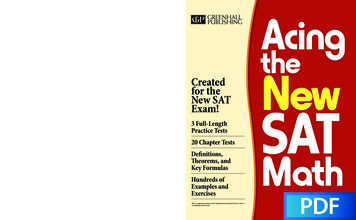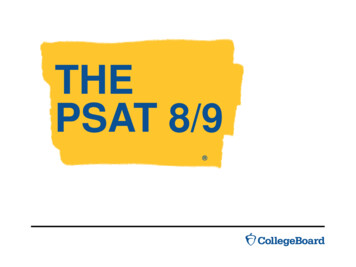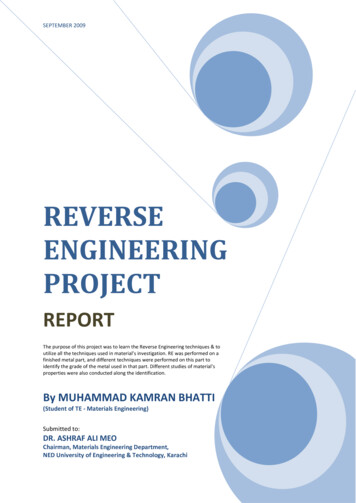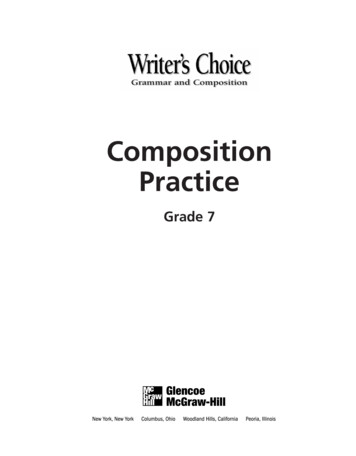
Transcription
Grammar and CompositionCompositionPracticeGrade 7
Glencoe/McGraw-HillCopyright 2001 The McGraw-Hill Companies, Inc. All rights reserved. Permission isgranted to reproduce material contained herein on the condition that such material bereproduced only for classroom use; and be provided to students, teachers, and familieswithout charge; and be used solely in conjunction with Writer’s Choice. Any otherreproduction, for use or sale, is prohibited without written permission of the publisher.Printed in the United States of America.Send all inquiries to:Glencoe/McGraw-Hill8787 Orion PlaceColumbus, Ohio 43240ISBN 0-07-823287-2123456789ii02404 03 02 01 00
ContentsUnit 1Personal Writing1.11.21.31.41.51Unit 2The Writing Process2.12.22.32.42.52.62.72.82.92.102Unit 3Using the Writing Process . . . . . . . . . . . . . . . . . . . . . . . . . . . . . . . . . . . . . . . . 7Prewriting: Finding and Exploring a Topic . . . . . . . . . . . . . . . . . . . . . . . . . . 8Prewriting: Determining Purpose and Audience . . . . . . . . . . . . . . . . . . . . . . 9Prewriting: Ordering Ideas . . . . . . . . . . . . . . . . . . . . . . . . . . . . . . . . . . . . . . 10Drafting: Getting It in Writing . . . . . . . . . . . . . . . . . . . . . . . . . . . . . . . . . . . 11Revising: Evaluating a Draft . . . . . . . . . . . . . . . . . . . . . . . . . . . . . . . . . . . . . 12Revising: Making Paragraphs Effective. . . . . . . . . . . . . . . . . . . . . . . . . . . . . 13Revising: Creating Sentence Variety . . . . . . . . . . . . . . . . . . . . . . . . . . . . . . . 14Editing/Proofreading: Making Final Adjustments . . . . . . . . . . . . . . . . . . . . 15Publishing/Presenting: Sharing Your Writing. . . . . . . . . . . . . . . . . . . . . . . . 16Writing Process in Action . . . . . . . . . . . . . . . . . . . . . . . . . . . . . . . . . . . . . . . 17Descriptive Writing3.13.23.33.43.53.63Unit 4Writing About What’s Important to You . . . . . . . . . . . . . . . . . . . . . . . . . . . . 1Collecting Information . . . . . . . . . . . . . . . . . . . . . . . . . . . . . . . . . . . . . . . . . . 2Writing to Celebrate . . . . . . . . . . . . . . . . . . . . . . . . . . . . . . . . . . . . . . . . . . . . 3Writing About Yourself . . . . . . . . . . . . . . . . . . . . . . . . . . . . . . . . . . . . . . . . . . 4Responding to a Character . . . . . . . . . . . . . . . . . . . . . . . . . . . . . . . . . . . . . . . 5Writing Process in Action . . . . . . . . . . . . . . . . . . . . . . . . . . . . . . . . . . . . . . . . 6Writing to Show, Not Tell . . . . . . . . . . . . . . . . . . . . . . . . . . . . . . . . . . . . . . . 18Combining Observation and Imagination . . . . . . . . . . . . . . . . . . . . . . . . . . 19Choosing Details to Create a Mood . . . . . . . . . . . . . . . . . . . . . . . . . . . . . . . 20Organizing Details in a Description . . . . . . . . . . . . . . . . . . . . . . . . . . . . . . . 21Describing a Person. . . . . . . . . . . . . . . . . . . . . . . . . . . . . . . . . . . . . . . . . . . . 22Relating a Poem to Your Experience. . . . . . . . . . . . . . . . . . . . . . . . . . . . . . . 23Writing Process in Action . . . . . . . . . . . . . . . . . . . . . . . . . . . . . . . . . . . . . . . 24Narrative Writing4.14.24.34.4Telling a Good Story . . . . . . . . . . . . . . . . . . . . . . . . . . . . . . . . . . . . . . . . . . . 25Exploring Story Ideas . . . . . . . . . . . . . . . . . . . . . . . . . . . . . . . . . . . . . . . . . . 26Using Time Order in a Story. . . . . . . . . . . . . . . . . . . . . . . . . . . . . . . . . . . . . 27Writing Dialogue to Develop Characters . . . . . . . . . . . . . . . . . . . . . . . . . . . 28iii
Contents4.54.64.74Unit 5Expository Writing5.15.25.35.45.55.65.75.85.95.105.115Unit 6ivGiving Information and Explanations . . . . . . . . . . . . . . . . . . . . . . . . . . . . .33Organizing Informative Writing . . . . . . . . . . . . . . . . . . . . . . . . . . . . . . . . . .34Writing About Similarities and Differences . . . . . . . . . . . . . . . . . . . . . . . . .35Explaining How Something Works . . . . . . . . . . . . . . . . . . . . . . . . . . . . . . . .36Identifying Cause and Effect . . . . . . . . . . . . . . . . . . . . . . . . . . . . . . . . . . . . .37Reports: Narrowing a Topic . . . . . . . . . . . . . . . . . . . . . . . . . . . . . . . . . . . . .38Reports: Turning to Helpful Sources . . . . . . . . . . . . . . . . . . . . . . . . . . . . . .39Reports: Conducting an Interview . . . . . . . . . . . . . . . . . . . . . . . . . . . . . . . .40Reports: Organizing and Drafting . . . . . . . . . . . . . . . . . . . . . . . . . . . . . . . .41Reports: Revising and Presenting . . . . . . . . . . . . . . . . . . . . . . . . . . . . . . . . .42Comparing Two People . . . . . . . . . . . . . . . . . . . . . . . . . . . . . . . . . . . . . . . . .43Writing Process in Action . . . . . . . . . . . . . . . . . . . . . . . . . . . . . . . . . . . . . . .44Persuasive Writing6.16.26.36.46.56.66.76.86AnswersDrafting a Story. . . . . . . . . . . . . . . . . . . . . . . . . . . . . . . . . . . . . . . . . . . . . . . 29Evaluating a Story Opening . . . . . . . . . . . . . . . . . . . . . . . . . . . . . . . . . . . . . 30Responding to a Story . . . . . . . . . . . . . . . . . . . . . . . . . . . . . . . . . . . . . . . . . . 31Writing Process in Action . . . . . . . . . . . . . . . . . . . . . . . . . . . . . . . . . . . . . . . 32Using Persuasive Writing . . . . . . . . . . . . . . . . . . . . . . . . . . . . . . . . . . . . . . .45Forming an Opinion . . . . . . . . . . . . . . . . . . . . . . . . . . . . . . . . . . . . . . . . . . .46Gathering Evidence . . . . . . . . . . . . . . . . . . . . . . . . . . . . . . . . . . . . . . . . . . . .47Developing an Argument . . . . . . . . . . . . . . . . . . . . . . . . . . . . . . . . . . . . . . .48Polishing an Argument . . . . . . . . . . . . . . . . . . . . . . . . . . . . . . . . . . . . . . . . .49Writing Publicity . . . . . . . . . . . . . . . . . . . . . . . . . . . . . . . . . . . . . . . . . . . . . .50Writing a Letter of Complaint . . . . . . . . . . . . . . . . . . . . . . . . . . . . . . . . . . .51Writing a Movie Review . . . . . . . . . . . . . . . . . . . . . . . . . . . . . . . . . . . . . . . .52Writing Process in Action . . . . . . . . . . . . . . . . . . . . . . . . . . . . . . . . . . . . . . .53. . . . . . . . . . . . . . . . . . . . . . . . . . . . . . . . . . . . . . . . . . . . . . . . . . . . . . . . . . . . . . . . . . . . . . . . .54
Composition PracticeName . Class . Date .1.1Writing About What’s Important to YouKey InformationWhen you do personal writing, you are free to focus on whatever is important to you.Personal writing offers you a way to examine and understand your innermost thoughts andfeelings. A. Writing About MyselfWrite your thoughts and feelings about each of the following statements. You maywrite formally or informally. Let your feelings lead the way.Accomplishments or personal qualities that I’m proud ofPeople or situations that make me laughEvents that I hope will happen somedayCopyright The McGraw-Hill Companies, Inc.Situations that make me feel nervousThings that make me sad sometimes B. Writing About What’s ImportantChoose one of the topics you listed in Part A. Write a paragraph telling about the topicand explaining why you feel the way you do. Try to include words and images thatreflect your unique personal outlook. Use additional paper if necessary.Writer’s Choice: Composition Practice, Grade 7, Unit 1 1
Composition PracticeName . Class . Date .1.2Collecting InformationKey InformationRecord daily happenings in a journal. By writing in a journal, you can explore your reactionsto events in your life. A journal can serve as a snapshot of you and your world for every daythat you write in it. A. Examining Your DayYesterday may have been a typical day, or it may have been special. Think about yesterday. Record what you did during each part of the day. For each part, comment aboutyour feelings.What you didYour feelingsIn the morningAt lunchtimeAfter lunch B. Writing a Journal EntryCopyright The McGraw-Hill Companies, Inc.Write a journal entry about the day you described above. Remember that a good journal entry is one that includes events as well as your reactions to them. Use words thatyou use in everyday conversation, as if you were talking to yourself or a friend. Makesure you write something you can share with your teacher.2 Writer’s Choice: Composition Practice, Grade 7, Unit 1
Composition PracticeName . Class . Date .1.3Writing to CelebrateKey InformationPersonal notes, letters, cards, and invitations are important links between you and yourfriends. When you take the time to write personal messages, you share a little bit of yourselfwith the important people in your life. A. Getting StartedDid you ever put off writing a note or letter that you knew you should write?Sometimes getting started is the hardest part. Practice getting off to a good start bywriting a first sentence for each of the following kinds of personal messages. Try tomake your mood clear through your choice of words.1. an invitation to a surprise party2. a letter to a friend who moved awayCopyright The McGraw-Hill Companies, Inc.3. a note to an adult family member, thanking him or her for a gift4. an invitation to a school concert in which you’ll perform B. Writing a Personal MessageFinish one of the personal messages you began in Part A. Think about who will be reading your message. That will help you select the best words to use. If you choose the invitation, you’ll need to include information about the time, date, and place of the event.Writer’s Choice: Composition Practice, Grade 7, Unit 1 3
Composition PracticeName . Class . Date .1.4Writing About YourselfKey InformationSometimes you experience something so unusual or memorable that you want to describe itto a wide audience. In this case your writing must be more formal than other kinds of personal writing. Word choice and sentence structure should follow the accepted rules. A. Planning Your WritingImagine that you have just appeared on a TV game show where you won prizes galore.You want to write about what happened to you as a contestant. Fill in the cluster diagram below with details of the experience and your feelings about it. Include detailsabout what you saw, heard, and felt. B. Writing About a Personal ExperienceThink of a time when you felt a strong emotion such as joy, fear, or surprise. Write ashort paragraph describing what happened and how you felt about it. Begin with asentence that clearly shows the emotion you experienced.4 Writer’s Choice: Composition Practice, Grade 7, Unit 1Copyright The McGraw-Hill Companies, Inc.I won bigon aTV game show!
Composition PracticeName . Class . Date .WRITING1.5ABOUTLITERATUREResponding to a CharacterKey InformationCharacters in stories you read often seem as real as your family and friends. As you learnabout them, you form opinions about them and their actions. A. Learning About a CharacterRead the following excerpt about a girl who is determined to tame a wild horse. As youread, think about whether or not you would follow the same course of action that shetakes.I started to walk slowly toward the pony. I expected him to shy off to the far end of thecorral. Instead he ran straight at me.I was too surprised to move. . . . He charged right at me and bit my arm. I had on a heavyjacket, so it wasn’t too bad, but it made me mad. I didn’t have a rope so I grabbed hismane and jerked his head down. . . . After a minute he quieted down, but I got a look athis eyes, and I knew he was figuring what to do next.Barbara Corcoran, The Cherub and My Sainted GrandmotherHow would you have felt if you had been the girl?Would you have acted the same way, or would you have done something else?Copyright The McGraw-Hill Companies, Inc. B. Writing a Response to a CharacterWrite a paragraph telling what you think about a character in a book or story. Select animportant incident from the plot, and explain why you believe the character did theright thing in that situation. Be sure to tell who the character is and what story he orshe appears in. Use additional paper if necessary.Writer’s Choice: Composition Practice, Grade 7, Unit 1 5
Composition PracticeName . Class . Date .1Writing Process in ActionKey InformationPersonal writing communicates your experiences and feelings. You can give your writingmore impact by including details that make the experience or feeling come alive for yourreader. Your writing should fit your intended audience. A. Recording DetailsImagine that you have experienced each of the following situations. Think of threedetails that communicate what happened and how you felt about the experience.Record the details in the space provided.1. a trip downtown2. a day at the beach3. a meal at a fast-food restaurant4. a walk through the parkWrite two paragraphs about an important moment in your life. The first paragraphshould be written for only you or a good friend to read. The second should be writtenfor a wider audience, such as the readers of the school newspaper. Use additional paperto jot down possible ideas for your paragraphs. When you have selected the importantmoment you plan to share, draft several sentences for each paragraph to help get yourself started. Be sure to keep each audience in mind as you write. Revise and edit yourwork, and write your finished paragraphs below or on another sheet of paper.6 Writer’s Choice: Composition Practice, Grade 7, Unit 1Copyright The McGraw-Hill Companies, Inc. B. Writing for Your Audience
Composition PracticeName . Class . Date .2.1Using the Writing ProcessKey InformationWhen developing a piece of writing, most writers go through a series of stages called thewriting process.Recognizing the Stages in the Writing ProcessReview the writing process. Then answer questions about two writing projects.PrewritingDecide on a topic, an audience, and a purpose. Find information and organize the ideas.DraftingPut your thoughts down on paper in sentences and paragraphs.RevisingReview the draft and change it to make the ideas clearer.Editing/ProofreadingCorrect errors in spelling, grammar, and punctuation.Publishing/PresentingShare your writing with an audience.1. Julie lost her cat. She hurriedly wrote a description of it and posted it on the bul-letin board of a neighborhood store. Later, when she saw her sign, she noticedsome spelling errors and unclear numerals in her phone number.Copyright The McGraw-Hill Companies, Inc.Was the prewriting stage hard or easy for Julie? Give reasons for your answer.Julie did not write her notice for school, and it was not graded. Did her skippingthe editing stage matter? Tell why or why not.2. Chou’s task was to summarize a twelve-page chapter in his textbook. His teacherchallenged him to state all the important ideas in half a page. His first version tookthree pages. His fourth version, finally, met the challenge.To which stage of the writing process did Chou give the most time? Explain.Other students in Chou’s class also summarized the chapter in less than half a page.Do you suppose all the papers were exactly the same? Why or why not?Writer’s Choice: Composition Practice, Grade 7, Unit 2 7
Composition PracticeName . Class . Date .Prewriting: Finding and Exploring a Topic2.2Key InformationKeeping a notebook and brainstorming are two ways to find ideas to write about. Clusteringcan help in developing a topic. When you cluster, you write down the topic and any relatedideas, drawing links to discover connections and areas of special interest. A. BrainstormingChoose one of the general topics below. Circle your choice. In two or three minuteswrite ten ideas related to the topic. Do not work out connections or decide how stronga new idea is. Just write down a word or phrase about it.plantswild animalspetssportsmoviesmusictransportation B. Clustering C. Making ConnectionsChoose one line you drew above. In what way or ways are the ideas in the two ovalsconnected? Write a sentence explaining the connection you had in mind.8 Writer’s Choice: Composition Practice, Grade 7, Unit 2Copyright The McGraw-Hill Companies, Inc.Choose one idea you wrote in Part A. Write it in the center oval below. In the otherovals write names or phrases describing ideas, things, places, or people related to thatidea. Draw lines between the ovals to show connections.
Composition PracticeName . Class . Date .2.3Prewriting: Determining Purpose and AudienceKey InformationMost writing accomplishes one of these four purposes: telling a story, describing, informing,or persuading. A writer makes decisions about form, length, and style based on the purposefor his or her writing and the audience for whom the writing is intended. A. Considering PurposeUse the following questions to develop four different ideas about dogs. For each purpose describe an essay or story you might write.1. Telling a Story: Have you ever had a pet dog? Has a dog ever given you a problem? Whatpersonal experiences have you had with dogs?2. Describing: Is there a particular dog you could describe? A breed of dogs? Can you create aword picture of yourself with a certain dog?3. Informing: Have you ever done research on dogs before choosing one as a pet? What doCopyright The McGraw-Hill Companies, Inc.you know about training a dog or keeping it healthy?4. Persuading: Could you persuade your parents to let you own a dog? Should new regula-tions be passed to protect dogs or to protect people from dogs? B. Considering AudienceChoose one of the purposes for writing about dogs from Part A, and describe an audience for which you could write. Discuss the age of the audience, its attitude toward dogs,and anything else that would help you make your writing appealing to that audience.Writer’s Choice: Composition Practice, Grade 7, Unit 2 9
Composition PracticeName . Class . Date .2.4Prewriting: Ordering IdeasKey InformationAfter choosing your topic, purpose, and audience, you must decide what main ideas tocover. Then list reasons, events, or other details that you will use to develop each main idea.Finally, arrange your main ideas and your supporting details in an order that makes sense. A. Stating Main IdeasFor each of these writing assignments, list three main ideas that you would use toachieve the purpose. Use complete sentences.1. Describe the most interesting store you know.2. Tell what happened during your first lesson in swimming (or sewing or anotherskill).4. Persuade someone to join a certain hobby club. B. Putting Ideas in OrderReview the main ideas you wrote for the four topics in Part A. Number the main ideasin the order in which you would cover them in a piece of writing.10 Writer’s Choice: Composition Practice, Grade 7, Unit 2Copyright The McGraw-Hill Companies, Inc.3. Explain how to play a game of your choice.
Composition PracticeName . Class . Date .2.5Drafting: Getting It in WritingKey InformationStrong prewriting notes often ease you into writing or drafting. Other techniques that helpinclude imagining that you are writing as if to a friend, beginning at the easiest part, andconcentrating on one step at a time. During drafting you should try to get all your ideasdown quickly.Turning Notes into ParagraphsBelow are notes for an explanatory essay about Elijah McCoy, followed by the essay’sintroduction. Use the notes to write the next two paragraphs of the essay. Use additional paper if necessary.McCoy’s life Born about 1844 in Canada Parents escaped from slavery Studied engineering in Scotland Worked as fireman-oilman for railroads in Michigan Invented automatic lubricator in early 1870s Success of lubricator made him wealthyMcCoy’s invention Lubricator oiled locomotive parts continuously. Stops for oiling were no longer necessary.Copyright The McGraw-Hill Companies, Inc. Trains could run on schedule. McCoy adapted lubricator for other machines to make them run steadily. McCoy’s lubricators worked better than copies made by other people. Machinery owners wanted only McCoy’s original lubricators and asked for “thereal McCoy.”Have you ever heard the phrase “the real McCoy”? It means “the real thing” or “thebest of its kind,” not a substitute or imitation. Many people who study language believethe phrase originally referred to Elijah McCoy, an African American engineer.Writer’s Choice: Composition Practice, Grade 7, Unit 2 11
Composition PracticeName . Class . Date .2.6Revising: Evaluating a DraftKey InformationWhen evaluating a first draft, identify the main idea, and decide how well the writing supports that idea. Determine whether the writing accomplishes its purpose, and look for bothgood points and weaknesses. As a peer reviewer, suggest possible improvements. A. Criticizing PolitelyAs Catherine’s peer reviewer, you noted that her rhyming story for kindergarten children is very engaging. However, some of the vocabulary is too hard for little kids, andthe rhymes get in the way of the plot. Make suggestions to help Catherine improve herpaper, and point out any strengths. Remember that you should offer your commentsrespectfully. B. Reviewing a DraftThink of the Netherlands (Holland), and you think of windmills, canals, dikes, andwooden shoes. The Netherlands is known for these things because of the history ofthe land. You see, almost one-half of the Netherlands was made by humans. Theseareas are called polders. Polders are made by pumping out the water in a vast area ofwater. A dike is built around the area to be drained. The water is then pumped intoa network of canals that drain into the sea. Windmills were used to provide thepower to pump the water from an area and to keep the water pumped out. Thecanals also served as waterways. Dikes also help to keep water out and keep waterfrom flooding the polders. The network of canals in the Netherlands serves to drainor channel the water to the sea. The famous wooden shoes developed because thesewooden shoes protect the feet from damp or wet earth better than leather ones.Much of the culture or spirit of the Netherlands is deeply rooted in the creation ofpolders. The people of the Netherlands have continuously battled the sea by “building” land and keeping it from flooding. The Netherlands is densely populated.1. What do you understand the main idea to be? Does it come across clearly?2. Do the details in the paper support the main idea?3. What is the writer’s purpose? Does the writer achieve his or her purpose?4. Which parts, if any, seem unnecessary, confusing, or out of place?5. Suggest possible improvements.12 Writer’s Choice: Composition Practice, Grade 7, Unit 2Copyright The McGraw-Hill Companies, Inc.Here is a first draft of a report for a social studies class. Read the draft, and evaluate itby answering the questions that follow on a separate sheet of paper.
Composition PracticeName . Class . Date .2.7Revising: Making Paragraphs EffectiveKey InformationWhen revising, give special attention to main ideas. You may wish to change paragraphbreaks or rearrange sentences to put all the details about a single main idea in the sameparagraph. You may also choose to link main ideas by adding transitions, such as later, forexample, and as a result.Improving a ParagraphExamine the following paragraph, and answer the questions about it.My grandmother’s embroidery is the most beautiful stitching you can find anywhere. My mother can sew pretty well, but she doesn’t have time for it. All thewomen in Grandma’s village sewed clothes for themselves and their families.Grandma learned how to embroider when she was growing up in Vietnam. As ayoung girl, she learned to make tiny stitches and to sew beautiful designs. Mystitches aren’t tiny at all. She had a good reason to practice hard.1. Is the main idea of the paragraph stated in a topic sentence? If so, write the topicsentence below. If the main idea is not stated, write a phrase or sentence identifying it.2. Do all the sentences support the main idea? If not, which sentence(s) should be deleted?Copyright The McGraw-Hill Companies, Inc.Identify any such sentence by its first three words.3. Are all the details in the best possible order? Would adding (or deleting) a topicsentence improve the paragraph? Revise the paragraph and write your revision in the spaceprovided.Writer’s Choice: Composition Practice, Grade 7, Unit 2 13
Composition PracticeName . Class . Date .2.8Revising: Creating Sentence VarietyKey InformationImproving individual sentences makes your writing clearer and more lively. When you revise adraft, change fragments into sentences, and combine short, choppy sentences that expressclosely related ideas. Break run-ons and over-long sentences into shorter, simpler sentences.To avoid monotony, vary the length of your sentences and the order of your words andphrases. A. Improving SentencesAnswer the questions, and combine the sentences where possible.1. This recipe is for pancakes. It is an easy recipe. It uses canned pumpkin.Are the sentences on the same topic and closely related?If so, combine them in one sentence.2. Beethoven was born in 1770. Shakespeare was born in 1564.Are the sentences on the same topic and closely related?If so, combine them in one sentence, using the word and.3. Some breeds of hunting dogs are very old. The Salukis are one example.Are the sentences on the same topic and closely related? B. Improving a ParagraphRevise this paragraph according to the directions. Write the improved paragraph on aseparate sheet of paper.The story of Cinderella appears in many cultures. The heroine in the NativeAmerican version was called Little Burnt Face. The Chinese Cinderella relied on atalking fish instead of a fairy godmother. The version best known in America isfrom Europe. The French writer Charles Perrault included it in his collection offairy tales. The book was published in 1697.1. Move the phrase “in the Native American version” to the beginning of the secondsentence.2. Move the phrase “instead of a fairy godmother” to the beginning of the third sentence.3. Gain variety in sentence length by combining the last three sentences in one sen-tence that includes “from a collection of fairy tales by.”14 Writer’s Choice: Composition Practice, Grade 7, Unit 2Copyright The McGraw-Hill Companies, Inc.If so, combine them in one sentence, using the words such as.
Composition PracticeName . Class . Date .2.9Editing/Proofreading: Making Final AdjustmentsKey InformationYour last review of your writing is a time to look for errors in spelling, grammar, usage, punctuation, and capitalization. You should indicate corrections with proofreading symbols.Finally, make a clean copy of your work. A. Identifying ErrorsIn the following paragraph decide what, if anything, is wrong with each underlinedword or phrase. In the space provided explain what the error is and how to correct it.If nothing is wrong, write correct as is.It is the year (1) 400 the kingdom of Ghana is the most powerful in western Africa.It (2) controls rich mines of salt and gold, and caravans of merchants cross the(3) sahara (4) evry few weeks with goods to trade for these (5) resource. Cities aregrowing (6) wear the traders meet, with jobs for many (7) poeple. The (8) taxs collected on trade (9) supports the army and the (10) k
I was too surprised to move.He charged right at me and bit my arm. I had on a heavy jacket, so it wasn’t too bad, but it made me mad. I didn’t have a rope so I grabbed his mane and jerked his head down. . . . After a minute he quieted down, but I got a look


